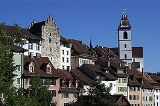
Aarau
Encyclopedia
Aarau is the capital of the northern Swiss
canton
of Aargau
. The city is also the capital of the district of Aarau
. It is German
-speaking and predominantly Protestant
. Aarau is situated on the Swiss plateau
, in the valley of the Aar, on the river's right bank, and at the southern foot of the Jura mountains
, and is west of Zurich
. The municipality borders directly on the Canton of Solothurn
to the west. It is the second-largest city in Aargau
after Wettingen
. At the beginning of 2010 Rohr
became a suburb of Aarau.
The neighboring municipalities are Küttigen
to the north, Rohr
and Buchs
to the east, Suhr
to the south-east, Unterentfelden
to the south, and Eppenberg-Wöschnau
and Erlinsbach
to the west.
Aarau and the nearby neighboring municipalities have grown together and now form an interconnected agglomeration
. The only exception is Unterentfelden whose settlements are divided from Aarau by the extensive forests of Gönhard and Zelgli.
Approximately nine tenths of the city is south of the Aar, and one tenth is to the north. It has an area, , of 8.9 km² (3.4 sq mi). Of this area, 6.3% is used for agricultural purposes, while 34% is forested. Of the rest of the land, 55.2% is settled (buildings or roads) and the remainder (4.5%) is non-productive (rivers or lakes). The lowest elevation, 365 metres (1,197.5 ft), is found at the banks of the Aar, and the highest elevation, at 471 metres (1,545.3 ft), is the Hungerberg on the border with Küttigen.
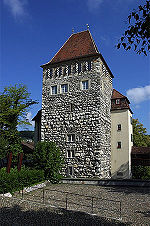
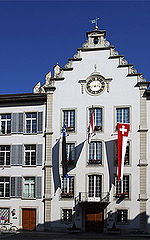
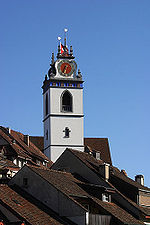
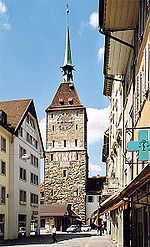 A few artifacts from the Neolithic
A few artifacts from the Neolithic
period were found in Aarau. Near the location of the present train station, the ruins of a settlement from the Bronze Age
(about 1000 BC) have been excavated. The Roman road between Salodurum (Solothurn
) and Vindonissa
passed through the area, along the route now covered by the Bahnhofstrasse. In 1976 divers in the Aar found part of a seven-meter wide wooden bridge from the late Roman times.
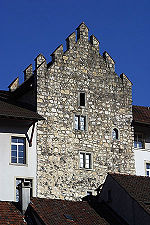 Aarau was founded around AD 1240 by the counts of Kyburg
Aarau was founded around AD 1240 by the counts of Kyburg
. Aarau is first mentioned in 1248 as Arowe. Around 1250 it was mentioned as Arowa. However the first mention of a city sized settlement was in 1256. The town was ruled from the "Rore" tower, which has been incorporated into the modern city hall.
In 1273 the counts of Kyburg died out. Agnes of Kyburg, who had no male relations, sold the family's lands to King Rudolf I von Habsburg
. He granted Aarau its city rights in 1283. In the 14th century the city was expanded in two stages, and a second defensive wall was constructed. A deep ditch separated the city from its "suburb;" its location is today marked by a wide street named "Graben" (meaning Ditch).
In 1415 Bern invaded lower Aargau with the help of Solothurn. Aarau capitulated after a short resistance, and was forced to swear allegiance to the new rulers. In the 16th century, the rights of the lower classes were abolished.
In March 1528 the citizens of Aarau allowed the introduction of Protestantism at the urging of the Bernese. A growth in population during the 16th Century led to taller buildings and denser construction methods. Early forms of industry developed at this time; however, unlike in other cities, no guilds were formed in Aarau.
Starting in the early 18th century, the textile industry was established in Aarau. German immigration contributed to the city's favorable conditions, in that they introduced the cotton and silk factories. These highly educated immigrants were also responsible for educational reform and the enlightened
, revolutionary spirit that developed in Aarau.
of the Old Swiss Confederacy
was held in Aarau. Two weeks later a French envoy continued to foment the revolutionary opinions of the city. The contrast between a high level of education and a low level of political rights was particularly great in Aarau, and the city refused to send troops to defend the Bernese border. By Mid-March 1798 Aarau was occupied by French troops.
On 22 March 1798 Aarau was declared the capital of the Helvetic Republic
. It is therefore the first capital of a unified Switzerland. Parliament met in the city hall. On 20 September, the capital was moved to Lucerne
.
ordered the fusion of the cantons of Aargau, Baden and Fricktal. Aarau was declared the capital of the new, enlarged canton of Aargau
. In 1820 the city wall was torn down, with the exception of the individual towers and gates, and the defensive ditches were filled in.
The wooden bridge, dating from the Middle Ages, across the Aar was destroyed by floods three times in thirty years, and was replaced with a steel suspension bridge in 1851. This was replaced by a concrete bridge in 1952. The city was linked up to the Swiss Central Railway
in 1856.
The textile industry in Aarau broke down in about 1850 because of the protectionist tariff policies of neighboring states. Other industries had developed by that time to replace it, including the production of mathematical instrument
s, shoes and cement. Beginning in 1900, numerous electrical enterprises developed. By the 1960s, more citizens worked in service industries or for the canton-level government than in manufacturing. During the 1980s many of the industries left Aarau completely.
In 1802 the Canton School was established; it was the first non-parochial high school in Switzerland. It developed a good reputation, and was home to Nobel Prize
winners Albert Einstein
, Paul Karrer
, and Werner Arber
, as well as several Swiss politicians and authors.
The purchase of a manuscript collection in 1803 laid the foundation for what would become the Cantonal Library, which contains a Bible
annotated by Huldrych Zwingli
. More newspapers developed in the city, maintaining the revolutionary atmosphere of Aarau. Beginning in 1820, Aarau has been a refuge for political refugees.
The urban educational and cultural opportunities of Aarau were extended through numerous new institutions. A Theatre and Concert Hall was constructed in 1883, which was renovated and expanded in 1995–96. The Aargau Nature Museum opened in 1922. A former cloth warehouse was converted into a small theatre in 1974, and the alternative culture center KIFF (Culture in the fodder factory) was established in a former animal fodder factory.
.
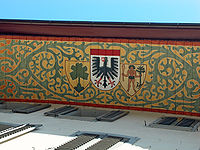 The historic old town forms an irregular square, consisting of four parts (called Stöcke). To the south lies the Laurenzenvorstadt, that is, the part of the town formerly outside the city wall. One characteristic of the city is its painted gables
The historic old town forms an irregular square, consisting of four parts (called Stöcke). To the south lies the Laurenzenvorstadt, that is, the part of the town formerly outside the city wall. One characteristic of the city is its painted gables
, for which Aarau is sometimes called the "City of beautiful Gables". The old town, Laurenzenvorstadt, government building, cantonal library, state archive and art museum are all listed as heritage sites of national significance
.
The buildings in the old city originate, on the whole, from building projects during the 16th century, when nearly all the Middle Age period buildings were replaced or expanded. The architectural development of the city ended in the 18th century, when the city began to expand beyond its (still existing) wall. Most of the buildings in the "suburb" date from this time.
The "Schlössli" (small Castle), Rore Tower and the upper gate tower have remained nearly unchanged since the 13th century. The "Schlössli" is the oldest building in the city. It was already founded at the time of the establishment of the city shortly after 1200; the exact date is not known. City hall was built around Rore Tower in 1515.
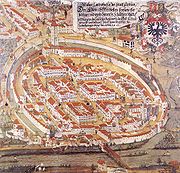 The upper gate tower stands beside the southern gate in the city wall, along the road to Lucerne and Bern. The jail has been housed in it since the Middle Ages. A Carillon
The upper gate tower stands beside the southern gate in the city wall, along the road to Lucerne and Bern. The jail has been housed in it since the Middle Ages. A Carillon
was installed in the tower in the middle of the 20th century, the bells for which were provided by the centuries-old bell manufacturers of Aarau.
The town church was built between 1471 and 1478. During the Reformation
, in 1528, its twelve altars and accompanying pictures were destroyed. The "Justice fountain" (Gerechtskeitbrunnen) was built in 1634, and is made of French limestone
; it includes a statue of Lady Justice made of sandstone
, hence the name. It was originally in the street in front of city hall, but was moved to its present location in front of the town church in 1905 due to increased traffic.
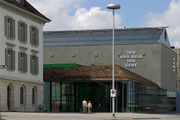 , Aarau had an unemployment rate of 2.35%. , there were 48 people employed in the primary economic sector and about 9 businesses involved in this sector. 4,181 people are employed in the secondary sector and there are 164 businesses in this sector. 20,186 people are employed in the tertiary sector, with 1,461 businesses in this sector. This is a total of over 24,000 jobs, since Aarau's population is about 16,000 it draws workers from many surrounding communities. there were 8,050 total workers who lived in the municipality. Of these, 4,308 or about 53.5% of the residents worked outside Aarau while 17,419 people commuted into the municipality for work. There were a total of 21,161 jobs (of at least 6 hours per week) in the municipality.
, Aarau had an unemployment rate of 2.35%. , there were 48 people employed in the primary economic sector and about 9 businesses involved in this sector. 4,181 people are employed in the secondary sector and there are 164 businesses in this sector. 20,186 people are employed in the tertiary sector, with 1,461 businesses in this sector. This is a total of over 24,000 jobs, since Aarau's population is about 16,000 it draws workers from many surrounding communities. there were 8,050 total workers who lived in the municipality. Of these, 4,308 or about 53.5% of the residents worked outside Aarau while 17,419 people commuted into the municipality for work. There were a total of 21,161 jobs (of at least 6 hours per week) in the municipality.
The largest employer in Aarau is the Canton government, the offices of which are distributed across the entire city at numerous locations. One of the two head offices of the Aargauer Zeitung
, Switzerland's fifth largest newspaper, is located in Aarau, as are the Tele M1 television channel studios, and several radio stations.
Kern & Co., founded in 1819, was an internationally known geodetic
instrument manufacturer based in Aarau. However, it was taken over by Wild Leitz in 1988, and was closed in 1991.
More than half of the workers in Aarau live in the city's suburbs, or farther away in the surrounding area. This leads to a busy rush hour, and regular traffic jams. Statistically, Aarau has the most jobs per capita of any Swiss city.
The small scale of Aarau causes it to continually expand the borders of its growth. The urban center lies in the middle of the "Golden Triangle" between Zurich
, Bern, and Basel
, and Aarau is having increasing difficulty in maintaining the independence of its economic base from the neighboring large cities. The idea of merging Aarau with its neighboring suburbs has been recently discussed in the hope of arresting the slowly progressing losses.
Manufacture include bells, mathematical instruments, electrical goods, cotton textiles, chemicals, shoes, and other products.
Aarau has a population (as of ) of . , 19.8% of the population was made up of foreign nationals. Over the last 10 years the population has grown at a rate of 1%. Most of the population speaks German (84.5%), with Italian being second most common ( 3.3%) and Serbo-Croatian being third ( 2.9%).
The age distribution, , in Aarau is; 1,296 children or 8.1% of the population are between 0 and 9 years old and 1,334 teenagers or 8.4% are between 10 and 19. Of the adult population, 2,520 people or 15.8% of the population are between 20 and 29 years old. 2,518 people or 15.8% are between 30 and 39, 2,320 people or 14.6% are between 40 and 49, and 1,987 people or 12.5% are between 50 and 59. The senior population distribution is 1,588 people or 10.0% of the population are between 60 and 69 years old, 1,219 people or 7.7% are between 70 and 79, there are 942 people or 5.9% who are between 80 and 89,and there are 180 people or 1.1% who are 90 and older.
, there were 1,365 homes with 1 or 2 persons in the household, 3,845 homes with 3 or 4 persons in the household, and 2,119 homes with 5 or more persons in the household. The average number of people per household was 1.99 individuals. there were 1,594 single family homes (or 18.4% of the total) out of a total of 8,661 homes and apartments.
In Aarau about 74.2% of the population (between age 25–64) have completed either non-mandatory upper secondary education or additional higher education (either University or a Fachhochschule
). Of the school age population , there are 861 students attending primary school, there are 280 students attending secondary school, there are 455 students attending tertiary or university level schooling, there are 35 students who are seeking a job after school in the municipality.
. The list includes three churches; the Christian Catholic
parish house, the Catholic parish house, and the Reformed City Church. There are five government buildings on the list; the Cantonal Library and Art Gallery, the old Cantonal School, the Legislature, the Cantonal Administration building, and the archives. Three gardens or parks are on the list; Garten Schmidlin, Naturama Aargau and the Schlossgarten. The remaining four buildings on the list are; the former Rickenbach Factory, the Crematorium, the Haus zum Erker at Rathausgasse 10 and the Restaurant Zunftstube at Pelzgasse.
. Of the rest of the population, there are 51 individuals (or about 0.33% of the population) who belong to the Christian Catholic
i.e. Old Catholic faith.
. It is responsible for approving tax levels, preparing the annual account, and the business report. In addition, it can issue regulations. The term of office is four years. In the last two elections the parties had the following representation:
At the district level, some elements of the government remain a direct democracy. There are optional and obligatory referendums, and the population retains the right to establish an initiative.
. It leads and represents the municipality. It carries out the resolutions of the assembly, and those requested by the canton and national level governments.
The seven members (and their party) for the period 2006–2009 are:
the most popular party was the SP which received 27.9% of the vote. The next three most popular parties were the SVP (22.1%), the FDP
(17.5%) and the Green Party (11.8%).
of the municipal coat of arms
is Argent an Eagle displayed Sable beaked langued and membered Gules and a Chief of the last.
}}
Switzerland
Switzerland name of one of the Swiss cantons. ; ; ; or ), in its full name the Swiss Confederation , is a federal republic consisting of 26 cantons, with Bern as the seat of the federal authorities. The country is situated in Western Europe,Or Central Europe depending on the definition....
canton
Cantons of Switzerland
The 26 cantons of Switzerland are the member states of the federal state of Switzerland. Each canton was a fully sovereign state with its own borders, army and currency from the Treaty of Westphalia until the establishment of the Swiss federal state in 1848...
of Aargau
Aargau
Aargau is one of the more northerly cantons of Switzerland. It comprises the lower course of the river Aare, which is why the canton is called Aar-gau .-History:...
. The city is also the capital of the district of Aarau
Aarau (district)
Aarau District is a district in the Swiss Canton of Aargau with administrative capital Aarau encompasses the agglomeration of Aarau south of the Juras.-Geography: the Aargau District had a total area of...
. It is German
German language
German is a West Germanic language, related to and classified alongside English and Dutch. With an estimated 90 – 98 million native speakers, German is one of the world's major languages and is the most widely-spoken first language in the European Union....
-speaking and predominantly Protestant
Protestantism
Protestantism is one of the three major groupings within Christianity. It is a movement that began in Germany in the early 16th century as a reaction against medieval Roman Catholic doctrines and practices, especially in regards to salvation, justification, and ecclesiology.The doctrines of the...
. Aarau is situated on the Swiss plateau
Swiss plateau
The Swiss Plateau or Central Plateau constitutes one of the three major landscapes in Switzerland alongside the Jura mountains and the Swiss Alps. It covers about 30% of the Swiss surface...
, in the valley of the Aar, on the river's right bank, and at the southern foot of the Jura mountains
Jura mountains
The Jura Mountains are a small mountain range located north of the Alps, separating the Rhine and Rhone rivers and forming part of the watershed of each...
, and is west of Zurich
Zürich
Zurich is the largest city in Switzerland and the capital of the canton of Zurich. It is located in central Switzerland at the northwestern tip of Lake Zurich...
. The municipality borders directly on the Canton of Solothurn
Canton of Solothurn
Solothurn is a canton of Switzerland. It is located in the northwest of Switzerland. The capital is Solothurn.-History:The territory of the canton comprises land acquired by the capital...
to the west. It is the second-largest city in Aargau
Aargau
Aargau is one of the more northerly cantons of Switzerland. It comprises the lower course of the river Aare, which is why the canton is called Aar-gau .-History:...
after Wettingen
Wettingen
Wettingen is a residential community in the district of Baden in the Swiss canton of Aargau. With a population about 20,000, Wettingen is the largest municipality in the canton.-Geography:...
. At the beginning of 2010 Rohr
Rohr, Aargau
Until the first of January 2010 Rohr was a municipality in the district of Aarau in the canton of Aargau in Switzerland.At the beginning of 2010 Rohr became a suburb of Aarau.-Geography:...
became a suburb of Aarau.
Geography and geology
The old city of Aarau is situated on a rocky outcrop at a narrowing of the Aar river valley, at the southern foot of the Jura mountains. Newer districts of the city lie to the south and east of the outcrop, as well as higher up the mountain, and in the valley on both sides of the Aar.The neighboring municipalities are Küttigen
Küttigen
Küttigen is a municipality in the district of Aarau of the canton of Aargau in Switzerland.-History:Küttigen is first mentioned in 1036 as Chutingen though this comes from a 14th Century copy of the original. In 1045 it was mentioned as Chutingun....
to the north, Rohr
Rohr, Aargau
Until the first of January 2010 Rohr was a municipality in the district of Aarau in the canton of Aargau in Switzerland.At the beginning of 2010 Rohr became a suburb of Aarau.-Geography:...
and Buchs
Buchs, Aargau
-Government:In the 2007 federal election the most popular party was the SVP which received 35.9% of the vote. The next three most popular parties were the SP , the FDP and the CVP .-Legislative:...
to the east, Suhr
Suhr, Aargau
Suhr is a municipality in the district of Aarau of the canton of Aargau in Switzerland.-Geography:Suhr has an area, , of . Of this area, 29.9% is used for agricultural purposes, while 44.4% is forested...
to the south-east, Unterentfelden
Unterentfelden
Unterentfelden is a municipality in the district of Aarau of the canton of Aargau in Switzerland.-Geography:Unterentfelden has an area, , of . Of this area, 32.2% is used for agricultural purposes, while 30.4% is forested...
to the south, and Eppenberg-Wöschnau
Eppenberg-Wöschnau
Eppenberg-Wöschnau is a municipality in the district of Olten in the canton of Solothurn in Switzerland.-History:Eppenberg is first mentioned in 1294 as in Eppenberg. At the same time, Wöschnau was mentioned as in Weschnowe.-Geography:...
and Erlinsbach
Erlinsbach, Aargau
Erlinsbach is a municipality in the district of Aarau of the canton of Aargau in Switzerland.-History:Erlinsbach is first mentioned in 1173 as Arnlesbah. In 1220 it was mentioned as Erndespah and in the 14th Century it was known as Erlispach....
to the west.
Aarau and the nearby neighboring municipalities have grown together and now form an interconnected agglomeration
Agglomeration
In the study of human settlements, an urban agglomeration is an extended city or town area comprising the built-up area of a central place and any suburbs linked by continuous urban area. In France, INSEE the French Statistical Institute, translate it as "Unité urbaine" which means continuous...
. The only exception is Unterentfelden whose settlements are divided from Aarau by the extensive forests of Gönhard and Zelgli.
Approximately nine tenths of the city is south of the Aar, and one tenth is to the north. It has an area, , of 8.9 km² (3.4 sq mi). Of this area, 6.3% is used for agricultural purposes, while 34% is forested. Of the rest of the land, 55.2% is settled (buildings or roads) and the remainder (4.5%) is non-productive (rivers or lakes). The lowest elevation, 365 metres (1,197.5 ft), is found at the banks of the Aar, and the highest elevation, at 471 metres (1,545.3 ft), is the Hungerberg on the border with Küttigen.
Prehistory




Neolithic
The Neolithic Age, Era, or Period, or New Stone Age, was a period in the development of human technology, beginning about 9500 BC in some parts of the Middle East, and later in other parts of the world. It is traditionally considered as the last part of the Stone Age...
period were found in Aarau. Near the location of the present train station, the ruins of a settlement from the Bronze Age
Bronze Age
The Bronze Age is a period characterized by the use of copper and its alloy bronze as the chief hard materials in the manufacture of some implements and weapons. Chronologically, it stands between the Stone Age and Iron Age...
(about 1000 BC) have been excavated. The Roman road between Salodurum (Solothurn
Solothurn
The city of Solothurn is the capital of the Canton of Solothurn in Switzerland. The city also comprises the only municipality of the district of the same name.-Pre-roman settlement:...
) and Vindonissa
Vindonissa
Vindonissa was a Roman legion camp at modern Windisch, Switzerland. It was probably established in 15 AD. In an expansion around 30, thermal baths were added....
passed through the area, along the route now covered by the Bahnhofstrasse. In 1976 divers in the Aar found part of a seven-meter wide wooden bridge from the late Roman times.
Middle Ages

Kyburg
Kyburg may refer to:*Henry E. Kyburg, Jr., the philosopher/logician*The castle Kyburg in the Canton of Zurich*The municipality surrounding the castle, Kyburg, Zurich*The noble House of Kyburg that took their name from the castle....
. Aarau is first mentioned in 1248 as Arowe. Around 1250 it was mentioned as Arowa. However the first mention of a city sized settlement was in 1256. The town was ruled from the "Rore" tower, which has been incorporated into the modern city hall.
In 1273 the counts of Kyburg died out. Agnes of Kyburg, who had no male relations, sold the family's lands to King Rudolf I von Habsburg
Habsburg
The House of Habsburg , also found as Hapsburg, and also known as House of Austria is one of the most important royal houses of Europe and is best known for being an origin of all of the formally elected Holy Roman Emperors between 1438 and 1740, as well as rulers of the Austrian Empire and...
. He granted Aarau its city rights in 1283. In the 14th century the city was expanded in two stages, and a second defensive wall was constructed. A deep ditch separated the city from its "suburb;" its location is today marked by a wide street named "Graben" (meaning Ditch).
In 1415 Bern invaded lower Aargau with the help of Solothurn. Aarau capitulated after a short resistance, and was forced to swear allegiance to the new rulers. In the 16th century, the rights of the lower classes were abolished.
In March 1528 the citizens of Aarau allowed the introduction of Protestantism at the urging of the Bernese. A growth in population during the 16th Century led to taller buildings and denser construction methods. Early forms of industry developed at this time; however, unlike in other cities, no guilds were formed in Aarau.
Starting in the early 18th century, the textile industry was established in Aarau. German immigration contributed to the city's favorable conditions, in that they introduced the cotton and silk factories. These highly educated immigrants were also responsible for educational reform and the enlightened
Age of Enlightenment
The Age of Enlightenment was an elite cultural movement of intellectuals in 18th century Europe that sought to mobilize the power of reason in order to reform society and advance knowledge. It promoted intellectual interchange and opposed intolerance and abuses in church and state...
, revolutionary spirit that developed in Aarau.
1798: Capital of the Helvetic Republic
On 27 December 1797, the last TagsatzungTagsatzung
The Swiss Tagsatzung was the legislative and executive council of the Swiss confederacy from the beginnings until the formation of the Swiss federal state in 1848. It was a meeting of delegates of the individual cantons...
of the Old Swiss Confederacy
Old Swiss Confederacy
The Old Swiss Confederacy was the precursor of modern-day Switzerland....
was held in Aarau. Two weeks later a French envoy continued to foment the revolutionary opinions of the city. The contrast between a high level of education and a low level of political rights was particularly great in Aarau, and the city refused to send troops to defend the Bernese border. By Mid-March 1798 Aarau was occupied by French troops.
On 22 March 1798 Aarau was declared the capital of the Helvetic Republic
Helvetic Republic
In Swiss history, the Helvetic Republic represented an early attempt to impose a central authority over Switzerland, which until then consisted mainly of self-governing cantons united by a loose military alliance, and conquered territories such as Vaud...
. It is therefore the first capital of a unified Switzerland. Parliament met in the city hall. On 20 September, the capital was moved to Lucerne
Lucerne
Lucerne is a city in north-central Switzerland, in the German-speaking portion of that country. Lucerne is the capital of the Canton of Lucerne and the capital of the district of the same name. With a population of about 76,200 people, Lucerne is the most populous city in Central Switzerland, and...
.
Aarau as canton capital
In 1803, NapoleonNapoleon I of France
Napoleon Bonaparte was a French military and political leader during the latter stages of the French Revolution.As Napoleon I, he was Emperor of the French from 1804 to 1815...
ordered the fusion of the cantons of Aargau, Baden and Fricktal. Aarau was declared the capital of the new, enlarged canton of Aargau
Aargau
Aargau is one of the more northerly cantons of Switzerland. It comprises the lower course of the river Aare, which is why the canton is called Aar-gau .-History:...
. In 1820 the city wall was torn down, with the exception of the individual towers and gates, and the defensive ditches were filled in.
The wooden bridge, dating from the Middle Ages, across the Aar was destroyed by floods three times in thirty years, and was replaced with a steel suspension bridge in 1851. This was replaced by a concrete bridge in 1952. The city was linked up to the Swiss Central Railway
Swiss Central Railway
The Swiss Central Railway was a Swiss railway company from 1853 to 1902.In 2005 the name Centralbahn was revived for new railway company created by the merger of the Luzern-Stans-Engelberg-Bahn and the Brünigbahn...
in 1856.
The textile industry in Aarau broke down in about 1850 because of the protectionist tariff policies of neighboring states. Other industries had developed by that time to replace it, including the production of mathematical instrument
Mathematical instrument
A mathematical instrument is a tool or device used in the study or practice of mathematics.Most instruments are used within the field of geometry, including the ruler, dividers, protractor, set square, compass, ellipsograph and opisometer...
s, shoes and cement. Beginning in 1900, numerous electrical enterprises developed. By the 1960s, more citizens worked in service industries or for the canton-level government than in manufacturing. During the 1980s many of the industries left Aarau completely.
In 1802 the Canton School was established; it was the first non-parochial high school in Switzerland. It developed a good reputation, and was home to Nobel Prize
Nobel Prize
The Nobel Prizes are annual international awards bestowed by Scandinavian committees in recognition of cultural and scientific advances. The will of the Swedish chemist Alfred Nobel, the inventor of dynamite, established the prizes in 1895...
winners Albert Einstein
Albert Einstein
Albert Einstein was a German-born theoretical physicist who developed the theory of general relativity, effecting a revolution in physics. For this achievement, Einstein is often regarded as the father of modern physics and one of the most prolific intellects in human history...
, Paul Karrer
Paul Karrer
Paul Karrer was a Swiss organic chemist best known for his research on vitamins. He and Walter Haworth won the Nobel Prize for Chemistry in 1937.-Early years:...
, and Werner Arber
Werner Arber
Werner Arber is a Swiss microbiologist and geneticist. Along with American researchers Hamilton Smith and Daniel Nathans, Werner Arber shared the 1978 Nobel Prize in Physiology or Medicine for the discovery of restriction endonucleases...
, as well as several Swiss politicians and authors.
The purchase of a manuscript collection in 1803 laid the foundation for what would become the Cantonal Library, which contains a Bible
Bible
The Bible refers to any one of the collections of the primary religious texts of Judaism and Christianity. There is no common version of the Bible, as the individual books , their contents and their order vary among denominations...
annotated by Huldrych Zwingli
Huldrych Zwingli
Ulrich Zwingli was a leader of the Reformation in Switzerland. Born during a time of emerging Swiss patriotism and increasing criticism of the Swiss mercenary system, he attended the University of Vienna and the University of Basel, a scholarly centre of humanism...
. More newspapers developed in the city, maintaining the revolutionary atmosphere of Aarau. Beginning in 1820, Aarau has been a refuge for political refugees.
The urban educational and cultural opportunities of Aarau were extended through numerous new institutions. A Theatre and Concert Hall was constructed in 1883, which was renovated and expanded in 1995–96. The Aargau Nature Museum opened in 1922. A former cloth warehouse was converted into a small theatre in 1974, and the alternative culture center KIFF (Culture in the fodder factory) was established in a former animal fodder factory.
Origin of the name
The earliest use of the place name was in 1248 (in the form Arowe), and probably referred to the settlement in the area before the founding of the city. It comes, along with the name of the River Aar (which was called Arula, Arola, and Araris in early times), from the German Au, meaning floodplainFloodplain
A floodplain, or flood plain, is a flat or nearly flat land adjacent a stream or river that stretches from the banks of its channel to the base of the enclosing valley walls and experiences flooding during periods of high discharge...
.
Old town

Gables
Gables may refer to:* Gables, portion of walls between the lines of sloping roofs* Ken Gables , Major League Baseball pitcher* Gables, Nebraska, an unincorporated community in the United States...
, for which Aarau is sometimes called the "City of beautiful Gables". The old town, Laurenzenvorstadt, government building, cantonal library, state archive and art museum are all listed as heritage sites of national significance
Swiss Inventory of Cultural Property of National and Regional Significance
The Swiss Inventory of Cultural Property of National and Regional Significance is a register of some 8,300 items of cultural property in Switzerland...
.
The buildings in the old city originate, on the whole, from building projects during the 16th century, when nearly all the Middle Age period buildings were replaced or expanded. The architectural development of the city ended in the 18th century, when the city began to expand beyond its (still existing) wall. Most of the buildings in the "suburb" date from this time.
The "Schlössli" (small Castle), Rore Tower and the upper gate tower have remained nearly unchanged since the 13th century. The "Schlössli" is the oldest building in the city. It was already founded at the time of the establishment of the city shortly after 1200; the exact date is not known. City hall was built around Rore Tower in 1515.

Carillon
A carillon is a musical instrument that is typically housed in a free-standing bell tower, or the belfry of a church or other municipal building. The instrument consists of at least 23 cast bronze, cup-shaped bells, which are played serially to play a melody, or sounded together to play a chord...
was installed in the tower in the middle of the 20th century, the bells for which were provided by the centuries-old bell manufacturers of Aarau.
The town church was built between 1471 and 1478. During the Reformation
Protestant Reformation
The Protestant Reformation was a 16th-century split within Western Christianity initiated by Martin Luther, John Calvin and other early Protestants. The efforts of the self-described "reformers", who objected to the doctrines, rituals and ecclesiastical structure of the Roman Catholic Church, led...
, in 1528, its twelve altars and accompanying pictures were destroyed. The "Justice fountain" (Gerechtskeitbrunnen) was built in 1634, and is made of French limestone
Limestone
Limestone is a sedimentary rock composed largely of the minerals calcite and aragonite, which are different crystal forms of calcium carbonate . Many limestones are composed from skeletal fragments of marine organisms such as coral or foraminifera....
; it includes a statue of Lady Justice made of sandstone
Sandstone
Sandstone is a sedimentary rock composed mainly of sand-sized minerals or rock grains.Most sandstone is composed of quartz and/or feldspar because these are the most common minerals in the Earth's crust. Like sand, sandstone may be any colour, but the most common colours are tan, brown, yellow,...
, hence the name. It was originally in the street in front of city hall, but was moved to its present location in front of the town church in 1905 due to increased traffic.
Economy

The largest employer in Aarau is the Canton government, the offices of which are distributed across the entire city at numerous locations. One of the two head offices of the Aargauer Zeitung
Aargauer Zeitung
Aargauer Zeitung is the leading regional newspaper in the Canton of Aargau, Switzerland. Edited in Baden and Aarau, the German language daily has a circulation of 129,000...
, Switzerland's fifth largest newspaper, is located in Aarau, as are the Tele M1 television channel studios, and several radio stations.
Kern & Co., founded in 1819, was an internationally known geodetic
Geodesy
Geodesy , also named geodetics, a branch of earth sciences, is the scientific discipline that deals with the measurement and representation of the Earth, including its gravitational field, in a three-dimensional time-varying space. Geodesists also study geodynamical phenomena such as crustal...
instrument manufacturer based in Aarau. However, it was taken over by Wild Leitz in 1988, and was closed in 1991.
More than half of the workers in Aarau live in the city's suburbs, or farther away in the surrounding area. This leads to a busy rush hour, and regular traffic jams. Statistically, Aarau has the most jobs per capita of any Swiss city.
The small scale of Aarau causes it to continually expand the borders of its growth. The urban center lies in the middle of the "Golden Triangle" between Zurich
Zürich
Zurich is the largest city in Switzerland and the capital of the canton of Zurich. It is located in central Switzerland at the northwestern tip of Lake Zurich...
, Bern, and Basel
Basel
Basel or Basle In the national languages of Switzerland the city is also known as Bâle , Basilea and Basilea is Switzerland's third most populous city with about 166,000 inhabitants. Located where the Swiss, French and German borders meet, Basel also has suburbs in France and Germany...
, and Aarau is having increasing difficulty in maintaining the independence of its economic base from the neighboring large cities. The idea of merging Aarau with its neighboring suburbs has been recently discussed in the hope of arresting the slowly progressing losses.
Manufacture include bells, mathematical instruments, electrical goods, cotton textiles, chemicals, shoes, and other products.
Markets and fairs
Every Saturday morning there is a vegetable market in the Graben at the edge of the Old City. It is supplied with regional products. In the last week of September the MAG (Market of Aarauer Tradesmen) takes place there, with regional companies selling their products. The "Rüeblimärt" is held in the same place on the first Wednesday in November, which is a Carrot fair. The Aarau fair is held at the ice skating rink during the Spring.Population
The population of Aarau grew continuously from 1800 until about 1960, when the city reached a peak population of 17,045, more than five times its population in 1800. However, since 1960 the population has fallen by 8%. There are three reasons for this population loss: firstly, since the completion of Telli (a large apartment complex), the city has not had any more considerable land developments. Secondly, the number of people per household has fallen; thus, the existing dwellings do not hold as many people. Thirdly, population growth was absorbed by neighboring municipalities in the regional urban area, and numerous citizens of Aarau moved into the countryside. This trend might have stopped since the turn of the 21st century. Existing industrial developments are being used for new purposes instead of standing empty.Aarau has a population (as of ) of . , 19.8% of the population was made up of foreign nationals. Over the last 10 years the population has grown at a rate of 1%. Most of the population speaks German (84.5%), with Italian being second most common ( 3.3%) and Serbo-Croatian being third ( 2.9%).
The age distribution, , in Aarau is; 1,296 children or 8.1% of the population are between 0 and 9 years old and 1,334 teenagers or 8.4% are between 10 and 19. Of the adult population, 2,520 people or 15.8% of the population are between 20 and 29 years old. 2,518 people or 15.8% are between 30 and 39, 2,320 people or 14.6% are between 40 and 49, and 1,987 people or 12.5% are between 50 and 59. The senior population distribution is 1,588 people or 10.0% of the population are between 60 and 69 years old, 1,219 people or 7.7% are between 70 and 79, there are 942 people or 5.9% who are between 80 and 89,and there are 180 people or 1.1% who are 90 and older.
, there were 1,365 homes with 1 or 2 persons in the household, 3,845 homes with 3 or 4 persons in the household, and 2,119 homes with 5 or more persons in the household. The average number of people per household was 1.99 individuals. there were 1,594 single family homes (or 18.4% of the total) out of a total of 8,661 homes and apartments.
In Aarau about 74.2% of the population (between age 25–64) have completed either non-mandatory upper secondary education or additional higher education (either University or a Fachhochschule
Fachhochschule
A Fachhochschule or University of Applied Sciences is a German type of tertiary education institution, sometimes specialized in certain topical areas . Fachhochschulen were founded in Germany and later adopted by Austria, Liechtenstein, Switzerland and Greece...
). Of the school age population , there are 861 students attending primary school, there are 280 students attending secondary school, there are 455 students attending tertiary or university level schooling, there are 35 students who are seeking a job after school in the municipality.
| Population Growth | |||||||
|---|---|---|---|---|---|---|---|
| year | population | Swiss Nationals | % German Speaking | % Italian Speaking Italian language Italian is a Romance language spoken mainly in Europe: Italy, Switzerland, San Marino, Vatican City, by minorities in Malta, Monaco, Croatia, Slovenia, France, Libya, Eritrea, and Somalia, and by immigrant communities in the Americas and Australia... |
% Romansh Speaking | % Protestant Protestantism Protestantism is one of the three major groupings within Christianity. It is a movement that began in Germany in the early 16th century as a reaction against medieval Roman Catholic doctrines and practices, especially in regards to salvation, justification, and ecclesiology.The doctrines of the... |
% Roman Catholic Roman Catholic Church The Catholic Church, also known as the Roman Catholic Church, is the world's largest Christian church, with over a billion members. Led by the Pope, it defines its mission as spreading the gospel of Jesus Christ, administering the sacraments and exercising charity... |
| 1558 | ca. 1,200 | ||||||
| 1764 | 1, 868 | ||||||
| 1798 | 2, 458 | ||||||
| 1850 | 4,657 | 4,299 | 0.0% | 0.0% | 0.0% | 0.0% | 0.0% |
| 1880a | 5,914 | 5,381 | 99.2% | 0.7% | 0.2% | 81.9% | 17.4% |
| 1910 | 9,593 | 7,986 | 90.6% | 2.2% | 6.7% | 71.7% | 26.6% |
| 1930 | 11,666 | 10,472 | 95.3% | 1.7% | 2.3% | 72.7% | 25.4% |
| 1950 | 14,280 | 13,373 | 93.8% | 2.2% | 3.2% | 70.4% | 27.9% |
| 1970 | 16,881 | 13,782 | 82.4% | 1.6% | 11.2% | 60.1% | 37.6% |
| 1990 | 16,481 | 13,146 | 81.7% | 1.0% | 5.3% | 49.7% | 33.0% |
Heritage sites of national significance
Aarau is home to a number of sites that are listed as Swiss heritage sites of national significanceSwiss Inventory of Cultural Property of National and Regional Significance
The Swiss Inventory of Cultural Property of National and Regional Significance is a register of some 8,300 items of cultural property in Switzerland...
. The list includes three churches; the Christian Catholic
Christian Catholic Church of Switzerland
The Christian Catholic Church of Switzerland is the Swiss member church of the Union of Utrecht, also known as Old Catholic Church, originally founded by the jansenists, with a later influx of discontented Catholics following their disappointment with the First Vatican Council. It has 14,000...
parish house, the Catholic parish house, and the Reformed City Church. There are five government buildings on the list; the Cantonal Library and Art Gallery, the old Cantonal School, the Legislature, the Cantonal Administration building, and the archives. Three gardens or parks are on the list; Garten Schmidlin, Naturama Aargau and the Schlossgarten. The remaining four buildings on the list are; the former Rickenbach Factory, the Crematorium, the Haus zum Erker at Rathausgasse 10 and the Restaurant Zunftstube at Pelzgasse.
Religion
From the , 4,473 or 28.9% are Roman Catholic, while 6,738 or 43.6% belonged to the Swiss Reformed ChurchSwiss Reformed Church
The Reformed branch of Protestantism in Switzerland was started in Zürich by Huldrych Zwingli and spread within a few years to Basel , Bern , St...
. Of the rest of the population, there are 51 individuals (or about 0.33% of the population) who belong to the Christian Catholic
Christian Catholic Church of Switzerland
The Christian Catholic Church of Switzerland is the Swiss member church of the Union of Utrecht, also known as Old Catholic Church, originally founded by the jansenists, with a later influx of discontented Catholics following their disappointment with the First Vatican Council. It has 14,000...
i.e. Old Catholic faith.
Legislative
In place of a town meeting, a town assembly (Einwohnerrat) of 50 members is elected by the citizens, and follows the policy of proportional representationProportional representation
Proportional representation is a concept in voting systems used to elect an assembly or council. PR means that the number of seats won by a party or group of candidates is proportionate to the number of votes received. For example, under a PR voting system if 30% of voters support a particular...
. It is responsible for approving tax levels, preparing the annual account, and the business report. In addition, it can issue regulations. The term of office is four years. In the last two elections the parties had the following representation:
| Party | 2001 | 2005 |
|---|---|---|
| FDP | 13 | 12 |
| SP Social Democratic Party of Switzerland The Social Democratic Party of Switzerland is the largest centre-left political party in Switzerland.... |
12 | 12 |
| SVP Swiss People's Party The Swiss People's Party , also known as the Democratic Union of the Centre , is a conservative political party in Switzerland. Chaired by Toni Brunner, but spearheaded by Christoph Blocher, the party is the largest party in the Federal Assembly, with 58 members of the National Council and 6 of... |
11 | 9 |
| CVP Christian Democratic People's Party of Switzerland The Christian Democratic People's Party of Switzerland is a Christian democratic political party in Switzerland. It is the fourth-largest party in the National Council, with 31 seats, and the largest in the Council of States, with 15 seats. It has one seat, that of Doris Leuthard, on the Swiss... |
4 | 4 |
| Pro Aarau | 4 | 4 |
| Green Green Party of Switzerland The Green Party of Switzerland is the fifth-largest party in the National Council of Switzerland, and the largest party that is not represented on the Federal Council.-History:... |
2 | 4 |
| EVP Evangelical People's Party of Switzerland The Evangelical People's Party of Switzerland is a political party in Switzerland.In questions of redistribution, education, environmentalism, immigration policy, the EVP stands rather center-left. In questions of euthanasia, abortion, and registered partnership and other typically Christian... |
3 | 3 |
| JETZT! | 1 | 2 |
At the district level, some elements of the government remain a direct democracy. There are optional and obligatory referendums, and the population retains the right to establish an initiative.
Executive
The executive authority is the town council (Stadtrat). The term of office is four years, and its members are elected by a plurality voting systemPlurality voting system
The plurality voting system is a single-winner voting system often used to elect executive officers or to elect members of a legislative assembly which is based on single-member constituencies...
. It leads and represents the municipality. It carries out the resolutions of the assembly, and those requested by the canton and national level governments.
The seven members (and their party) for the period 2006–2009 are:
- Dr. Marcel Guignard (FDP) (City President)
- Beat Blattner (SP) (City Vice President)
- Jolanda Urech (SP)
- Rudolf Zinniker (FDP)
- Lukas Pfisterer (FDP)
- Carlo Mettauer (CVP)
- Michael Ganz (Pro Aarau)
National elections
In the 2007 federal electionSwiss federal election, 2007
Elections to the Swiss Federal Assembly, the federal parliament of Switzerland, were held on Sunday, 21 October 2007. In a few cantons, a second round of the elections to the Council of States was held on 11 November, 18 November, and 25 November 2007...
the most popular party was the SP which received 27.9% of the vote. The next three most popular parties were the SVP (22.1%), the FDP
Free Democratic Party of Switzerland
The Free Democratic Party was a classical liberal political party in Switzerland. It was one of the major parties in Switzerland until its merger with the smaller classical liberal Liberal Party, to form FDP.The Liberals on 1 January 2009....
(17.5%) and the Green Party (11.8%).
Coat of arms
The blazonBlazon
In heraldry and heraldic vexillology, a blazon is a formal description of a coat of arms, flag or similar emblem, from which the reader can reconstruct the appropriate image...
of the municipal coat of arms
Coat of arms
A coat of arms is a unique heraldic design on a shield or escutcheon or on a surcoat or tabard used to cover and protect armour and to identify the wearer. Thus the term is often stated as "coat-armour", because it was anciently displayed on the front of a coat of cloth...
is Argent an Eagle displayed Sable beaked langued and membered Gules and a Chief of the last.
Notable residents
- Johann Kaspar Riesbeck (1754–1786), author and actor
- Johann Rudolf Dolder (1753–1807), politician
- Sebastian Fahrländer (1768–1841), politician, physician
- Johann Heinrich Daniel Zschokke (1771–1848), writer
- Ignaz Paul Vitalis Troxler (1780–1866), physician, politician, philosopher
- Carl Feer-Herzog (1820–1880), politician
- Albert EinsteinAlbert EinsteinAlbert Einstein was a German-born theoretical physicist who developed the theory of general relativity, effecting a revolution in physics. For this achievement, Einstein is often regarded as the father of modern physics and one of the most prolific intellects in human history...
(1879–1955) - Charles Tschopp (1899–1982), writer
- Born in Aarau:
- Eugen BircherEugen BircherEugen Bircher was a Swiss politician and military leader who became associated with a pro-German position in the inter-war years.- Military and political career :...
(1882–1956), politician - Erika BurkartErika BurkartErika Burkart was a Swiss writer and poet. She was the recipient of many awards, among them the Conrad-Ferdinand-Meyer-Preis, the Gottfried-Keller-Preis, the Joseph-Breitbach-Preis, and the Wolfgang-Amadeus-Mozart-Preis.She was born in Aarau in 1922 and died in Muri in 2010.-Poetry books:* Der...
(1922–2010), writer and poet - Ferdinand Rudolph HasslerFerdinand Rudolph HasslerFerdinand Rudolph Hassler was a surveyor who worked mostly in the United States and also in Switzerland. He headed the United States Coast Survey and the Bureau of Weights and Measures.-Biography:...
, (1770–1843), first director of the United States Coast Survey. - Maximilian Bircher-BennerMaximilian Bircher-BennerMaximilian Oskar Bircher-Benner was a Swiss physician and a pioneer in nutritional research....
- Urs Faes, author
- Friedrich Frey-HeroséFriedrich Frey-HeroséFriedrich Frey-Herosé was a Swiss politician.He was elected to the Swiss Federal Council on November 16, 1848 as one of the first seven members of the council...
(1801–1873), member of the Swiss Federal Council - Hans HerzogHans HerzogHans Herzog was a Swiss army officer, and was elected Switzerland's General during the Franco-Prussian War.Born in Aarau, he became an artillery lieutenant in 1840, and then spent six years in travelling , before he became a partner in his father's business in 1846...
(1819–1894), general - Paul HubschmidPaul HubschmidPaul Hubschmid was a Swiss actor. He appeared as Henry Higgins in a production of My Fair Lady. In some Hollywood films he used the name Paul Christian...
, actor - Klaus MerzKlaus Merz- Life :As a teacher , Merz has worked in adult education. He has won several prices, e.g. the famous „Hermann-Hesse-Literaturpreis“ in 1997, the „Gottfried Keller-Preis“ in 2004 and the „Werkpreis der schweizerischen Schillerstiftung“ in 2005....
, author - Nicolas Hunziker, Automotive Fine Artist
- Nicolas MüllerNicolas MüllerNicolas Müller, is a Swiss snowboarder noted for his smooth riding style and his ability to read different terrains and adjusting his riding to the terrain....
, snowboarder
- Eugen Bircher
Sister projects
}}}

